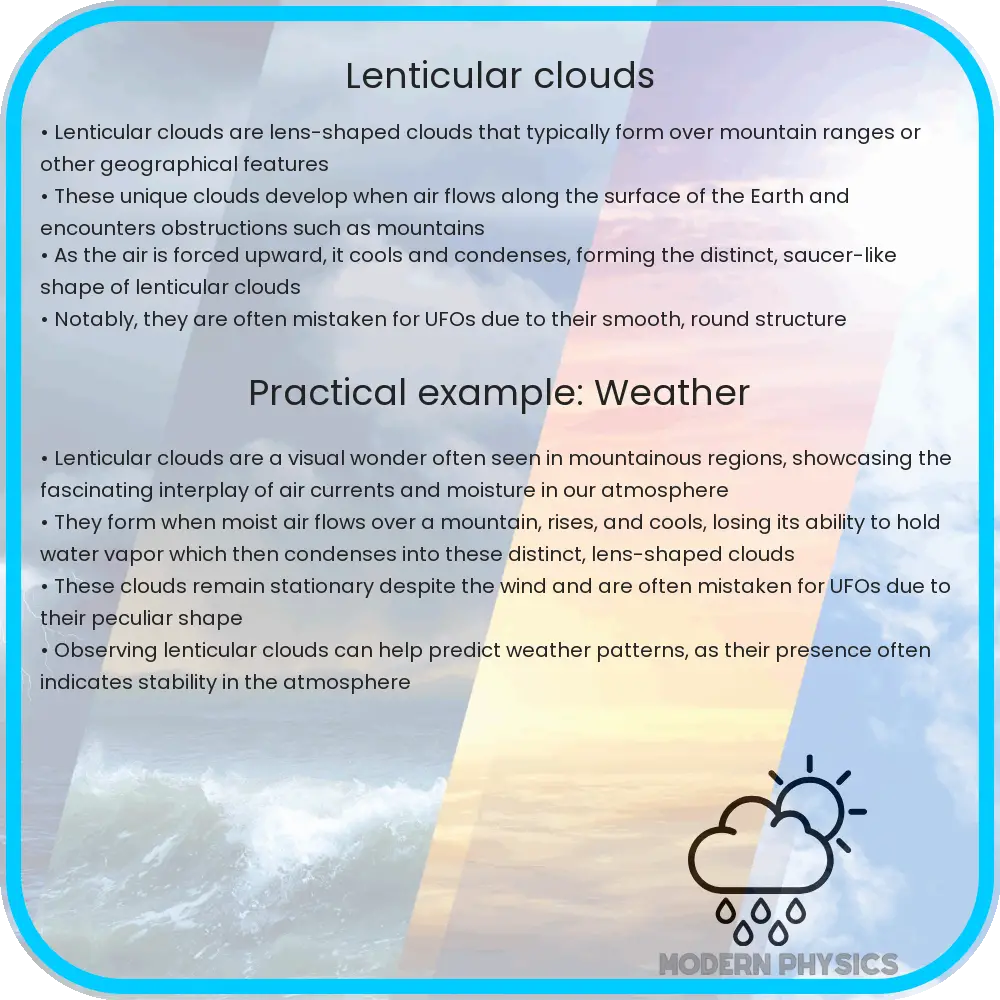Learn about lenticular clouds, stationary formations in the troposphere known for their lens-like shape and smooth, UFO-like appearance.

Understanding Lenticular Clouds: Formation and Meteorological Significance
Lenticular clouds, or Altocumulus lenticularis, are stationary cloud formations known for their lens-like shape and smooth appearance. These clouds are often mistaken for unidentified flying objects (UFOs) due to their distinct and dramatic visual structures. Their formation, sightings, and significance in meteorology offer a fascinating insight into the dynamic interactions within Earth’s atmosphere.
Formation of Lenticular Clouds
Lenticular clouds form primarily in the troposphere, typically aligning perpendicular to the wind direction. This occurs when moist air flows over elevated terrain, such as mountains or hills. The key process behind the formation of lenticular clouds involves orographic lift, where an airflow encounters topographic barriers.
Here’s a step-by-step breakdown of their formation:
- Wind Encounters a Barrier: As stable, moist air travels and hits a mountain or ridge, it is forced upward, leading to adiabatic cooling (cooling that happens when air expands at higher altitudes without external heat exchange).
- Air Reaches Dew Point: As the air continues to rise and cool, the temperature drops to the dew point, causing moisture in the air to condense and form cloud droplets.
- Wave Patterns: Once over the obstacle, the air tends to oscillate in a wavelike pattern. If conditions are right, the moisture continuously condenses at the crest of these waves, forming the cloud, and evaporates in the troughs, where the air descends and warms again.
- Cloud Stabilization: This process can create multiple, stacked layers due to the constant presence of waves, leading to the unique, saucer-like appearance of lenticular clouds.
The stability of the air is crucial for the maintenance of these distinct shapes. If the air is too turbulent, the cloud can disperse rather than forming clear, defined layers.
Sightings of Lenticular Clouds
Lenticular clouds are more commonly observed in mountainous regions due to their association with orographic uplift. Popular locations where these clouds are frequently seen include the Rockies in North America, the Andes in South America, and the Alps in Europe. However, they can form anywhere in the world where the atmospheric conditions align correctly.
Due to their distinct shape and appearance, these clouds are often a popular subject for photographers and weather enthusiasts. Their ability to form at different altitudes, sometimes appearing very close to the ground, adds to their mystique and the surreal landscape vistas they often create.
Meteorological Significance of Lenticular Clouds
Lenticular clouds are not just a visual spectacle; they also have significant meteorological implications. These clouds are indicators of the presence of strong atmospheric stability and may signal the onset of particular types of weather patterns, especially in mountainous regions. For instance, the presence of lenticular clouds can often predict the occurrence of strong winds or turbulence, which are critical information for aviation safety.
For meteorologists, observing these clouds helps in understanding the movement and behavior of air masses over mountainous terrain. They serve as natural gauges for measuring the speed and direction of air flow at higher altitudes. This information can be pivotal for improving weather forecasts and for ensuring the safety of flights over mountainous areas.
Environmental and Climate Considerations
Beyond their immediate meteorological importance, studying lenticular clouds also contributes to broader environmental and climate science. Since these clouds form under specific atmospheric conditions, changes in their frequency and location could indicate shifts in climate patterns. Monitoring these changes can provide valuable data for climate change studies, helping scientists predict how weather patterns might shift in a warming world.
Moreover, the study of cloud formations, including lenticular clouds, plays a crucial role in understanding Earth’s energy balance. Clouds affect the planet’s heat retention and distribution, influencing both local weather and global climate.
Conclusion
Lenticular clouds, with their unique lens-shaped appearance and capacity to signal atmospheric conditions, offer more than just aesthetic value—they are a crucial part of the atmospheric dynamics that influence our weather and climate. Whether serving as a stunning subject for photography or acting as a natural indicator for meteorological and environmental changes, lenticular clouds hold a significant place in the study of Earth’s atmosphere.
Understanding the formation, sighting, and significance of these clouds not only satiates the curiosity of weather enthusiasts but also equips meteorologists with the knowledge to make more accurate predictions about weather patterns, particularly in regions where these clouds are prevalent. For those living in or traveling through mountainous areas, being aware of the implications of lenticular clouds can help in better planning and preparedness for weather-related challenges.
In conclusion, our exploration of lenticular clouds encapsulates the intricate and fascinating interactions within Earth’s atmosphere, highlighting the beauty and scientific value of observing and studying such natural phenomena.
